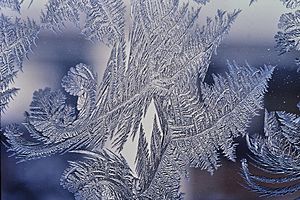Desublimation facts for kids
Desublimation is a special kind of change where a gas turns directly into a solid. It skips the liquid step completely! Think of it as the opposite of sublimation, which is when a solid turns directly into a gas.
You see desublimation happening all around you, especially when it's cold. It's how snow forms high up in clouds. It's also how frost and hoar frost appear on the ground, on plants, or on your windows during winter.
Another example is the soot you might see inside a chimney. When a fire burns, tiny soot particles rise as a hot gas. As this gas touches the cooler walls of the chimney, it changes directly into a solid soot layer. It doesn't become a liquid first.
This process is sometimes called deposition.
Contents
What is a Phase Change?
A phase change is when matter changes from one state to another. The main states of matter are solid, liquid, and gas. For example, when ice melts, it changes from a solid to a liquid. When water boils, it changes from a liquid to a gas. Desublimation is unique because it jumps straight from gas to solid.
How Does Desublimation Happen?
For desublimation to occur, the gas needs to cool down very quickly. It also needs to be at a certain pressure. When gas molecules lose enough energy, they slow down and stick together. If they lose energy fast enough, they don't have time to form a liquid. Instead, they arrange themselves directly into a solid structure.
Examples of Desublimation in Nature
Snow Formation
Snowflakes are a perfect example of desublimation. High in the clouds, tiny water vapor particles are gases. When the air temperature drops below freezing, these water vapor molecules can turn directly into ice crystals. These crystals then grow into the beautiful snowflakes we see falling.
Frost on Windows
Have you ever seen intricate frost patterns on a window on a cold morning? That's desublimation at work! Warm, moist air inside your house touches the very cold window glass. The water vapor in the air quickly loses heat and turns directly into solid ice crystals, forming those amazing designs.
Hoar Frost
Hoar frost is similar to window frost but forms on outdoor surfaces. When the ground or objects like grass and tree branches get very cold, and there's moisture in the air, water vapor can desublimate onto them. This creates a beautiful, feathery layer of ice crystals.
Desublimation in Everyday Life
Besides nature, desublimation can happen in other places too.
Soot in Chimneys
When wood or coal burns, it releases tiny particles as a hot gas. As these hot gases travel up the chimney, they touch the cooler chimney walls. The gas particles cool down very fast and turn directly into solid soot, sticking to the inside of the chimney.
Making Dry Ice
While making dry ice is usually done by compressing and cooling carbon dioxide gas until it becomes a liquid, then letting it expand to become a solid (which is freezing), sometimes desublimation can be involved in industrial processes where carbon dioxide gas is directly cooled to form solid dry ice. Dry ice is solid carbon dioxide.
Why is Desublimation Important?
Understanding desublimation helps scientists study weather patterns, especially how snow and ice form. It's also important in industries where gases need to be purified or stored as solids. For example, in some manufacturing processes, unwanted gases are removed by cooling them until they desublimate into solids.
See also
 In Spanish: Deposición (cambio de estado) para niños
In Spanish: Deposición (cambio de estado) para niños


